Jajangmyeon: The Tastiest Korean Black Bean Noodles
Did you know that about seven million people choose to eat jajangmyeon (Korean black bean noodles) in Korea every day? This impressive number, which ends up being about 1/7 of the total population, is a testament to this dish's popularity and delicious flavor.
What Is Jajangmyeon?
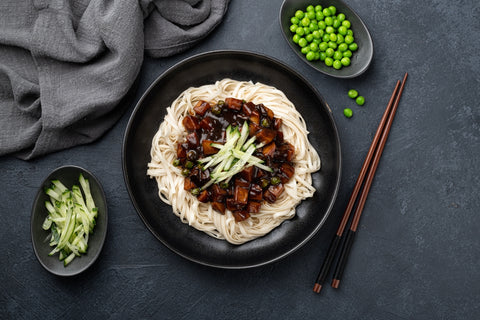
Jajangmyeon, or jjajangmyeon, is a Korean noodle dish topped with a thick black sauce made from chunjang (sweet bean paste), meats, and vegetables. The Korean black bean noodles are covered in a sweet bean sauce and are deliciously chewy.
They began as a Chinese recipe using Chinese black bean sauce. In the late 1800s and early 1900s, many Chinese people immigrated from China to Incheon (near Seoul). They brought certain dishes with them as they moved, like these black bean noodles.
Korean black bean noodles are based on a Chinese dish called zhajiangmian, translating to ”fried sauce noodles.” As the flavors of Korean cuisine and Chinese cuisine are slightly different, the recipe was altered to fit Korean taste buds. After the addition of brown sugar, jajangmyeon was born.
Now, this Korean Chinese food continues to be a popular everyday meal. It’s also served on special occasions such as birthdays, festivals, family holiday dinners, and graduations. Most people born in Korea have at least one fond memory of enjoying jajangmyeon with their family.
These days, jajangmyeon transcends traditional homemade recipes, and people can now enjoy its instant noodle versions from anywhere in the world.
One of the best instant jajangmyeon noodles on the US market is Nongshim Chapagetti Noodle. It fuses all of the sweet and savory ingredients of traditional jajangmyeon with the speed and convenience of instant noodles.
What Does Jajangmyeon Taste Like?
Korean black bean noodles have a delicious earthy, sweet, sour, decadent flavor. They’re served with chewy Korean noodles (or udon noodles). It’s also slightly spicy, which perfectly balances out the sweetness.
Vegetables like onions, cabbage, and zucchini are responsible for jajangmyeon’s mild sweetness. The rest of the dish’s flavor heavily depends on the type of chunjang (black bean paste) used to make the sauce. When jajangmyeon gets too bitter, there’s a chance the chunjang was stir-fried for too long or it was stir-fried too quickly.
Why Is Jajangmyeon So Popular?
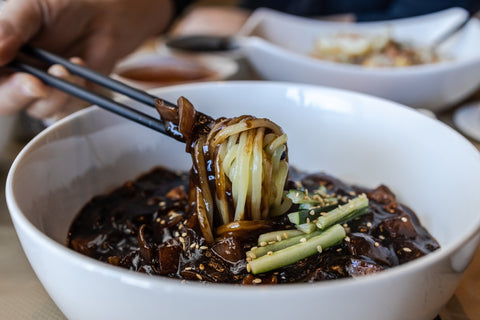
The short answer to jajangmyeon’s popularity is its convenience. It’s perfect for those with a busy schedule, as it’s easy to order and receive for delivery.
Whether you’re a busy college student, mother, or employee, you can have a fresh bowl of Korean black bean noodles sitting in front of you in no time. They’re also very affordable, making them an easy-to-choose meal.
Many Korean dramas include a shot of the characters eating this dish, as it's deeply rooted in Korean food culture. Jajangmyeon is one of the cheapest and most accessible dishes sold at restaurants and supermarkets in Korea. By combining the noodles and tasty sauce, people can enjoy a simple yet hearty meal.
For Koreans in diaspora, jajangmyeon helps to connect them to their origins and background by evoking the same feelings of happiness and warmth they had during their childhood in Korea.
The paste used to make jajangmyeon sauce is also an important part of Korean cuisine, as it’s widely used to add sweetness and umami flavors to any dish. You can discover the versatility and impact of jjajang black bean paste firsthand when you enjoy the Yopokki Instant Tteokbokki Rice Cake Cup: Jjajang Black Bean Paste. The bean paste adds a savory and slightly sweet flavor to the delicious cup of ramen and tteokbokki.
Commonly Used Jajangmyeon Ingredients
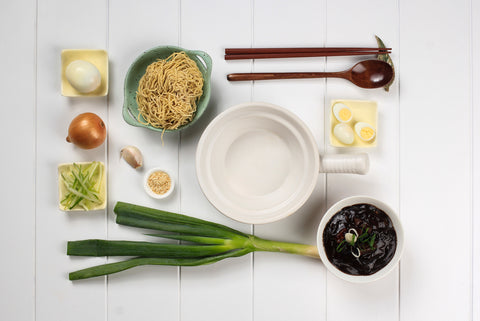
While there are various versions of Korean black bean noodles, there are some more traditional jajangmyeon ingredients that are often in use.
Below are some ingredients you can expect to see in a bowl of jajangmyeon. You’ll also find a quick set of instructions so you can make this Korean noodle dish at home.
-
Pork belly/pork shoulder
-
Vegetable oil (like sesame oil)
-
Freshly chopped Ginger
-
Onion
-
Cabbage
-
Cold water
-
Corn starch
-
Soy sauce
-
Salt
-
Akagi Joshu Akagi Udon
-
Korean noodles like Akagi Joshu Akagi Udon
-
Cucumber
Quick Jajangmyeon Recipe
These ingredients are pan-fried in a large pot on medium-high heat with oil. Then, the seasoning, water, and cornstarch slurry are added to help create the delicious black bean sauce. Next, the Korean noodles are boiled, stirring occasionally, until soft. The ingredients for these black bean sauce noodles are assembled with a topping of fresh cucumber. Your jajangmyeon is ready to be eaten!
Always use the Korean version of the black bean paste to make the chunjang, which typically consists of wheat flour, caramel sauce, soybeans, and the paste. If you substitute the black beans with the Chinese version, you’re no longer making jajangmyeon. Ready-made chunjang is often available at Asian markets and grocery stores.
You can substitute the pork for chicken, beef, or seafood. Some vegan recipes allow for mushrooms and fried tofu instead.
Besides the vegetable toppings we listed earlier, more unique alternatives include carrots and green peas.
If you have left-over jajangmyeon sauce after your meal, feel free to store it for up to 5 days in the fridge. Allow the sauce to cool off and put it in an airtight container before transferring it to the fridge.
Different Types of Jajangmyeon
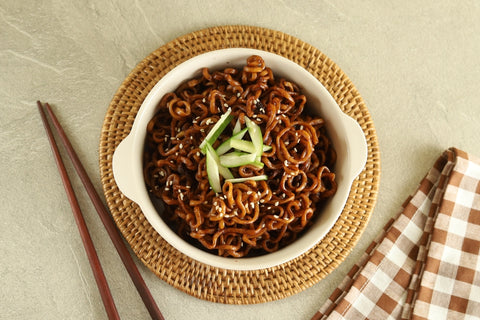
There are quite a few variations of Korean black bean noodles, including options with fried black bean paste. Here are some of the varieties you may see at a restaurant.
Gan-jjajang
Jjajang translates to noodle sauce (like in jjajangmyeon). Gan means “dry” in English. This Korean black bean noodle variety is a drier version than the standard jjajangmyeon. It's similar to the above recipe, except you do not add the water or cornstarch slurry.
Jaengban-jjajang
While the ingredients remain the same in this variation, the cooking method changes slightly. In this version, the noodles are stir-fried in a wok with the sauce. Afterward, jaengban-jjajang is served on a plate (not a bowl).
Yuni-jjajang
One major difference between this version and traditional Korean black bean noodles is the protein. Traditionally, pork belly is added. However, this version incorporates ground meat instead.
Sacheon Jajang
This is the spiciest type of jajangmyeon and is very popular in Korea. You can make it by adding red chilli pepper, powder, or flakes to the recipe. Sacheon jajangmyeon tends to incorporate seafood such as octopus and shrimp. The most common type of spice used to make spicy jajangmyeon is gochugaru (Korean red chili pepper flakes).
Uni Jajang
Cut the ingredients for traditional jajangmyeon into extremely small pieces to make this. The process releases some moisture, which is then used to cook the dish without adding water. Uni jajang is ideal for kids and older people because of its mild taste.
Yetnal Jajang
In Korean, this dish translates to “old jajangmyeon.” Compared to other types of jajangmyeon, the ingredients used in yetnal jajang are larger and its sauce is thinner. It also includes potatoes, which gives the sauce a softer taste.
Jjamjamyeon
This dish consists of both jajangmyeon and jjamppong, divided in the middle of a bowl. If you’ve never heard of jjamppong, it’s another popular Korean-Chinese noodle dish. Jjamppong, however, combines different kinds of seafood or pork with a red and spicy soup base made with gochugaru. Many Korean-Chinese restaurants that serve jjamjamyeon use a special bowl with double partitioning to keep the jajangmyeon and jjamppong halves separate from each other, giving you the best of both meals in a single order.
Jajangbap
Jajangbap is the most unique kind of jajangmyeon. It replaces the noodles in the jajangmyeon recipe with cooked rice. Every other preparation process or ingredient remains the same as the other types of jajangmyeon. Hence, it’s just as delicious. Jajangbap is a fantastic dish to pair with kimchi.
Sauce Variations
Sauce variations have the same (or most of the same) base ingredients. Slight modifications to the sauce of these noodles are what create the variations of these Korean Chinese dishes. For example, some recipes have brown sugar, and some don’t. Some sauce variations use pork belly for flavoring, while others rely on chopped fresh vegetables and broth.
You can also find sauces flavored with chicken. However, this is difficult for a novice to pull off. Thankfully, you can enjoy the taste easily when you cook the Samyang Buldak Ramen Bowl: Jjajang Hot Chicken. Weighing 105 g, it’s much larger than standard noodle sizes on the market and is perfect for making a family meal.
Jajangmyeon and Black Day In Korea
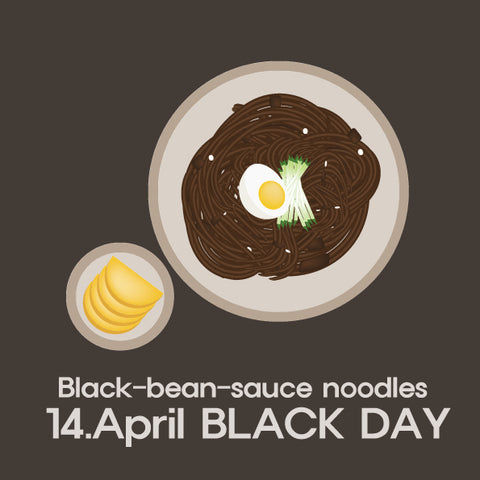
Black Day is an unofficial day in Korea. It falls on the same day every year, April 14th. This "holiday" is celebrated typically by those who are single. It's a day when you "drown your sorrows" by eating black food. Korean black bean noodles are especially popular on this day, and many celebrate the unofficial holiday by chowing down on a large bowl of Korean black bean noodles.
Hungry yet? Check out Bokksu Market for snacks and meals that will be delivered right to your door. You can find various instant noodle versions of the beloved jajangmyeon that take only a few minutes to create. Feel free to explore Bokksu’s other Asian snacks for more delicious items to stock in your pantry.
Author Bio










